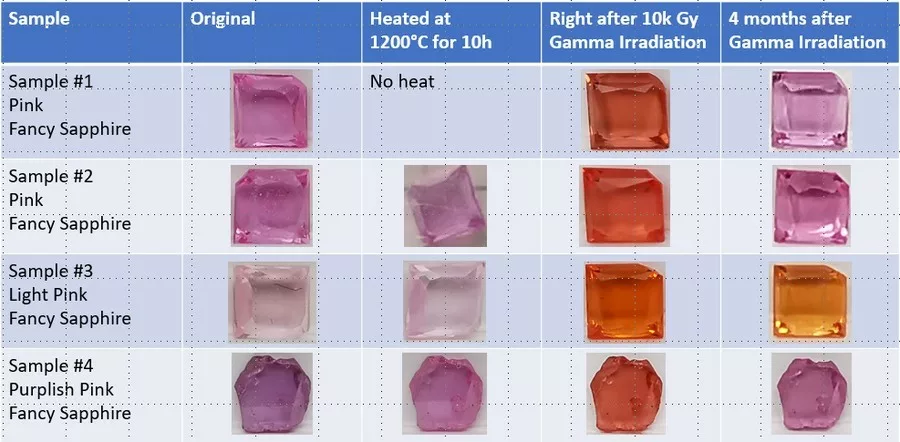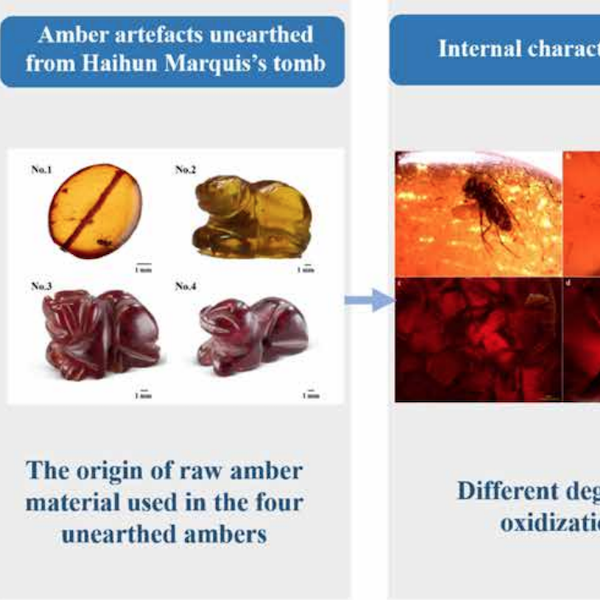Effects of Gamma Irradiation on Ruby and Pink Sapphire and Potential Detection Methods in Gem Labs
By Hao A.O. Wang, Dirk Weltz, Michael S. Krzemnicki, Andreas Mack, Markus Wälle
Keywords: Ruby, Pink sapphire, Gamma irradiation, UV-VIS, Raman, R-Line
Gamma irradiation is a non-destructive and non-invasive treatment method used to enhance the colour and aesthetic appeal of gemstones, such as diamond, topaz, quartz, and sapphire. In this process, high-energy gamma rays emitted – either from radioactive isotopes typically cobalt-60 (60Co) or from a linear accelerator (LINAC) – introduce point defects by displacing or ionizing atoms in the crystal structure of a gemstone. The resulting electron movement may create colour centres, inducing a desired colour change that ranges from subtle to dramatic, depending on the chemical composition of the stone and irradiation conditions.
Gamma irradiation has been investigated as a treatment method for corundum for decades (Johnson and Grow 1964, Nassau 1983). Following the initial development of ruby lasers in the 1960s, much research has been dedicated to understanding the influence of gamma radiation on ruby, primarily in relation to alterations in laser properties (Johnson and Grow 1967, Brown and Brown 1981). Within gemmology, the focus has largely been on examining how gamma irradiation can modify the color or hue of yellow or pale-colored corundum to achieve a deeper shade (Nassau and Valente 1987).
Although previously reported (Ashbuugh 1988), more recently, evidence from multiple trustworthy sources has indicated that some rubies and fancy sapphires in pink or purple shades may undergo gamma irradiation before entering the marketplace, which initiate immediate actions in gem labs to detect this treatment (Pardieu et al. 2022, Scarratt – personal communication 2022, Leelawatanasuk – personal communication 2022, Krzemnicki 2022, Krzemnicki 2023). It is believed that this gamma irradiation treatment is carried out in medical facilities, utilizing cancer radiotherapy equipment to enhance the corundum’s color. This practice is driven by the desire to decrease the purple hue in purple sapphires and rubies to reach a better red or pink color, or to increase the yellow hue in pink sapphires, resulting in a pinkish orange colour that is highly coveted in the gemstone industry – the Padparadscha sapphire.
Since more than a year, the Swiss Gemmological Institute SSEF is collaborating with the Swiss Neuro Radiosurgery Center with the aim to better understand the effect of gamma-irradiation on Cr-bearing corundum and to develop subsequentially potential methods to detect such irradiated corundum. So far, we have conducted a series of gamma irradiation experiments on corundum samples with colors ranging from light pink to dark red. Some of the samples were annealed (1200°C for 10h) before gamma irradiation to eliminate any potential residual effects from previous treatments on the host gemstone and reset (anneal) the zircon inclusions. The reason for this pre-treatment process was to make the effects of gamma irradiation more pronounced and discernible. A LINAC instrument (ZAP-X, Gyroscopic Radiosurgery platform, USA) was used as the gamma source to irradiate the gemstones. This device features a well-defined 3D radiation profile and offers accurate dose control. The samples were exposed to a total radiation dose of 10,000 Gray in increments of 2,000 Gray. Following the irradiation experiments, immediate visual inspection was conducted. Various analytical methods, such as UV-VIS absorption spectroscopy and ruby R-line fluorescence analysis were applied to compare the results before and after gamma irradiation. In addition to the effects on the host gemstone, the impact on zircon inclusions within the fancy sapphires was assessed using Raman micro-spectroscopy.


The study reveals that gamma irradiation has a notable effect on the colour of pink sapphire, causing a shift from pink or purple hues to orange (Figure 1). However, this colour transformation appears to be generally unstable, as most pink sapphires revert to their original colour within a few months. However, in our samples, there was one exception (light pink sapphire Sample #3) which after exposure to gamma irradiation retained its orange hue, albeit with reduced intensity, for more than four months without reverting to its initial color. Even after undergoing a fading test, the orange shade of Sample #3 persists and is deemed stable. Hence, it can be deduced that at least two types of colour centres might be involved in this scenario. One color center might be stable, while the other is unstable. In contrast, the colour of our ruby slices (dark red) did not exhibit any noticeable change after gamma irradiation (Figure 2). These observations on our corundum samples indicate that the effect of gamma irradiation might differ between high Cr and low Cr corundum (Powell 1966).
Furthermore, UV-VIS spectroscopy analysis demonstrates an increase in absorption at around 320 nm and 475nm after gamma irradiation (Figure 3). The absorption band at around 475nm is particularly interesting, since it did not increase after heat treatment, but only after gamma irradiation. A similar absorption band in ruby due to gamma irradiation has been described previously (Maruyama and Matsuda 1964). When a trapped hole (O-1) is formed near Fe3+ or Cr3+, which replaces Al3+ in the crystal lattice, a similar absorption band was reported to cause orange color in corundum (Dubinsky et al. 2020). Gamma irradiation might be responsible for the creation of the trapped holes, as a result showing an increased orange color in Cr-bearing corundum. However, UV-VIS absorption spectra are complex, and a deconvolution of absorption bands to corresponding chromophores is not yet achieved.

Unfortunately, at the time of this abstract submission for IGC 2023, neither colour change nor UV-VIS spectrum can offer conclusive evidence for detecting gamma-irradiated corundum, as the changes induced by gamma irradiation can also be present in natural, untreated stones (Nassau and Valente 1987, Dubinsky et al. 2020). It currently is only possible to detect the treatment when the stone has been analyzed in its pre-treatment state.
The broadening of zircon Raman peaks has been studied in literature (Nasdala et al. 1995; Zhu et al. 2015) and is caused by increased lattice disorder due to gamma radiation. In our experiment, results gathered from over ten zircon inclusions (fixed orientation) in each individual pink sapphire demonstrated no statistically significant indication of Raman peak broadening following gamma radiation. This observation could be attributed to the gamma irradiation dose being insufficient to induce any noticeable change. Conversely, the heat treatment (pre-treatment of our samples) significantly reduced the FWHM of zircon Raman peaks.
Ruby R-lines are fluorescence emission lines due to Cr3+ in the corundum lattice. Prior research has indicated that gamma irradiation may reduce the amount of Cr3+ in corundum, leading to the formation of Cr2+ and an expected decrease in R-line intensity. The presence of Cr2+ has been confirmed through thermal conductivity measurements (De Goer and Dreyfus 1967) and the reduction of Cr3+ has been confirmed through electron paramagnetic resonance (EPR) studies (Maruyama and Matsuda 1964). In our R-line experiment, excited by a 514.5 nm laser and analyzed by a Raman system, we observed a reduction in R-line intensity for gamma-irradiated pink sapphires, but not in dark red ruby. After leaving the pink sapphires at room temperature for four months, an increase in R-line intensity was observed, although not fully returning to the original state’s level.
Ongoing research is focused on exploring the relationship between R-line intensity and Cr concentration aiming at finding a more conclusive detection method for the gamma-irradiated ruby and pink sapphires. The naturally occurring proportion of Cr3+ in the total Cr content of corundum from specific geographic origins and with elemental compositions could potentially be determined and used as a benchmark for identifying gamma-irradiated Cr-bearing corundum, which may contain a disproportionally smaller portion of Cr3+. It is essential to note that this proposed detection method should incorporate additional evidence, such as increased absorption around 475nm in the UV-VIS spectrum. It is also crucial to consider that a fancy sapphire may have experienced natural irradiation if exposed to fluids containing radioactive elements. With the current techniques, it remains challenging to differentiate between naturally and artificially irradiated rubies or pink sapphires.
References:
- Ashbuugh, C. E., 1988. Gemstone Irradiation and Radioactivity. Gems & Gemology 24, no. 4, 196-213.
- Brown, I. J., and M. A. Brown, 1981. Low-Temperature Thermal Expansion of γ-Irradiated Ruby. Physical Review Letters 46, no. 13, 835-837.
- De Goer, A. M., and B. Dreyfus, 1967. γ-Irradiation Effect on the Thermal Conductivity of Al2O3 with Cr or Mn Impurities at Low Temperature. Physica Status Solidi 22, no. 1, 77-82.
- Dubinsky, E. V., J. Stone-Sundberg, and J. L. Emmett, 2020. A Quantitative Description of the Causes of Color in Corundum. Gems & Gemology 56, no. 1, 2-28.
- Johnson, V.R., and R.W. Grow, 1964. Gamma Irradiation Effects in Ruby. Proceedings of the IEEE 52, no. 2, 185-186.
- Johnson, V. R., and R. W. Grow, 1967. Effects of γ-Irradiation on the Performance of a Ruby Laser. IEEE Journal of Quantum Electronics QE-3, no. 1, 858-859.
- Krzemnicki, M. S., 2022. New Additional Test at SSEF for The Colour Stability of Rubies SSEF Newsletter. https://www. ssef.ch/new-additional-test-at-ssef-for-the-colour-stability-of-rubies/
- Krzemnicki, M. S., 2023. The Frontier of Research: Irradiation Experiments on Corundum. Facette no. 28, 40.
- Maruyama, T., and Y. Matsuda, 1964. Color Centers in γ-Irradiated Ruby. Journal of the Physical Society of Japan, no. 7, 1096-1104.
- Nasdala, L., G. Irmer, D. Wolf, 1995. The degree of metamictization in zircon; a Raman spectroscopic study. European Journal of Mineralogy 7, no. 3, 471–478.
- Nassau, K., 1983. The Physics and Chemistry of Color. John Wiley & Sons Inc, New York.
- Nassau, K., and G. K. Valente, 1987. The Seven Types of Yellow Sapphire and their Stability to Light. Gems & Gemology 23, no. 4, 222-231.
- Pardieu, V., K. Scarratt, R. Hughes, 2022. Irradiation of Rubies · A Cautionary Note. dated Feb. 23.
- Powell, R. C., 1966. The Interaction of Chromium Ions in Ruby Crystals. Physical Sciences Research Papers, no. 299. Massachusetts: Office of Aerospace Research.
- Zhu, W., L. Fan, and X. Lu, 2015. Structural evolution under gamma ray irradiation of zircon originated from Hainan province, China. In Proceedings of the 3rd International Conference on Material, Mechanical and Manufacturing Engineering. Guangzhou, China: Atlantis Press, 1748-1752.




